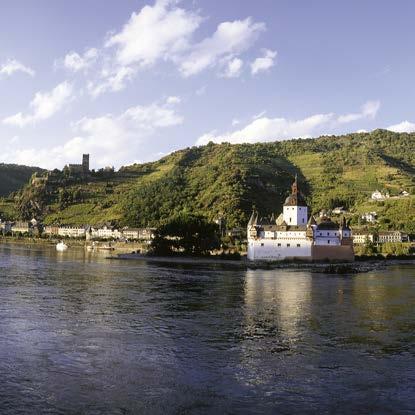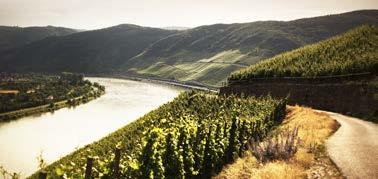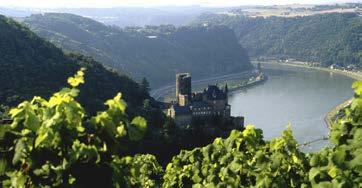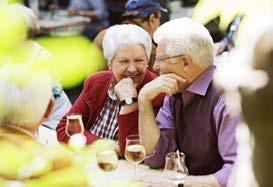
6 minute read
Mittelrhein
THE ESSENCE OF RHINE ROMANTICISM
The Rhine Valley between Bingen and Bonn is picturesque. Castle-crowned vineyard slopes and medieval villages adorn the riverbanks. This is the home of the Mittelrhein wine-growing region, where Romans planted the first vines. Its vineyards stretch for more than 100 km (62 miles) from Bingen up to the gateways of Bonn. This region along the Rhine is an especially beautiful part of Germany. The narrow valley with its countless rugged cliffs is an impressive landscape, not least because of the vineyards, most of which are on steep slopes. Yet tending vines here is extremely labor-intensive. The southern portion of this unique cultulral landscape – the Upper Middle Rhine Valley – was named a UNESCO World Heritage site in 2002. It is the heart of the region, with castles on the slopes and
Advertisement

charming villages on bends of the river. The Mittelrhein’s largest contiguous vineyard area extends for 5 km (3 miles) at Bopparder Hamm. It is not only a great vantage point, but also the site of “Mittelrheinischer Weinfrühling,” an outdoor celebration of springtime and the new vintage in late April.
The Mittelrhein is virtually synonymous with

rhine romanticism. Not only the legendary Loreley cliff. Numerous mighty fortresses and old castle ruins come into view in rapid succession. In the towns and villages, there is hardly an alley without a wine pub of some sort. worth seeking out is a “Haus der besten Schoppen.” These are restaurants with a particularly good selection of “Schoppen” (local wines by the glass).
wine-growers in the Mittelrhein cultivate vines almost exclusively on steep, terraced slopes. due to the difficult working conditions, the vineyard area has decreased to about 470 ha (1,161 acres). The region is divided into two districts: Siebengebirge (named after the “seven hills” south of Bonn) and Loreley. In order to increase quality, the average yield is only about 60 hl/ha. The very high quality of Mittelrhein wines stems from low yields, the vineyards’ proximity to the water and its tempering influence, and the barren, clayish slate soils of the steep slopes.
Traditional varietals are the vintners’ grapes of choice. Above all, riesling has ideal growing conditions here. It is the leading white wine grape in the Mittelrhein and accounts for 70 percent of the vineyard area. The wines are remarkable for their fine aromas, racy acidity and mineral tones. other white grapes cultivated here are Müller-Thurgau, Kerner and Pinots. Spätburgunder (Pinot Noir) is the most important red variety.
MITTELRHEIN – AT A GLANCE
Geographical location: The region stretches 100 km (62 miles) along the rhine from the confluence of the Nahe at Bingen to the confluence of the Mosel at Koblenz (left bank), and from Kaub to the “Seven Hills” near Bonn (right bank) · Climate: Many sunny days and sites protected from the wind; the rhine acts as a heat reservoir · Soils: weathered slate and graywacke, with patches of loess; in the north, soils of volcanic origin · Size: ca. 470 ha (1,161 acres) · Grape varieties: riesling, Spätburgunder (Pinot Noir), Müller-Thurgau

There are many destinations for excursions. In the heart of this unique river landscape lies Koblenz, a city with a long viticultural tradition. St. Goar and Boppard merit a visit, as does oberwesel, with its nearly intact medieval town wall. The old wine trade center Bacharach is very picturesque.
wine is celebrated year-round, be it the wine market in oberwesel or the wine festival in Bacharach or any number of wine presentations. during “Tal to Tal” one Sunday in June, streets are closed to motor traffic and lined with wine tasting stands for hikers, bikers and skaters. experience the rhine Valley in a cascade of colors during the “rhine in Flames” fireworks displays (five locations, from May to September). “weinforum Mittelrhein” is a comprehensive regional tasting in early September – more than 100 award-winning wines can be sampled.
Information: Mittelrhein-Wein e. V. Am Hafen 2 56329 St. Goar Tel. +49 (0)6741 77-12 Fax +49 (0)6741 77-23 www.mittelrhein-wein.com info@mittelrhein-wein.com
Mittelrhein: Landmarks of German Wine Culture
THE BOPPARDER HAMM ON THE RHEINSCHLEIFE, MITTELRHEIN
Boppard boasts two substantial claims to wine-related fame. For one, it lies close to the Rheinschleife, one of the most impressive bows in the Rhine River. For another, it is the site of the largest contiguous vineyard in the Mittelrhein region: the Bopparder Hamm. The derivation of the name is unclear. It might come from the Latin word “hamus” (hook), but some argue that it derives from the Rhenish expression “Hamm” (meaning riverbank). One thing is clear – the same term, Bopparder Hamm, is commonly used to refer both to vineyard and the curve in the river.

Rhine Bow, Wine Bow The steep vineyards of the Bopparder Hamm stretch across five kilometers (three miles) and cover 75 hectares (185 acres) of land to the left of the river. while the parcels are not easy to work, they do provide an optimal set of conditions for the vines. They are ideally angled and south facing and benefit from the reflective properties of the nearby rhine. Beyond this, the weathered slate soils store warmth during the day, releasing it slowly to the grapes long after the sun has set. riesling, with its characteristic steely minerality and racy acidity, is far and away the most planted vine in the Mittelrhein.
The cultivation of wine on the Bopparder Hamm dates back to at least roman times. In the mid-4th century a roman fort called Bodobrica was built to protect against the Germanic peoples on the other side of the rhine. Its walls have been maintained within the Boppard old city for over 16 centuries. The best way to enjoy a close-up view of the impressive cultural landscape around the Bopparder Hamm is via the hiking paths through the vineyards along the rheinschleife.
Tourist-Information Boppard, Karmeliterstraße 2 Tel. +49 (0)6742 3888 www.boppard-tourismus.de

BACHARACH – HEART OF THE ROMANTIC RHINE, MITTELRHEIN
“Near Bacharach on the Rhine/There Lived a Certain Witch...” So begins Clemens Brentano's ballad from 1801 about the beautiful and lovelorn Lore Lay, who throws herself from a cliff into the Rhine. The story unleashed a veritable boom in Romantic Rhine writing, drawing crowds of tourists to Bacharach and the Loreley cliff, some 12 kilometers (7.5 miles) down the river near Sankt Goarshausen.
Romanticized Rhine and Sentimentality Before Bacharach became the center of the romanticized rhine, it served as an important storage and transshipment center for rhine shipping. This function came partially through a peculiarity of geography. In Medieval times a rocky ridge known as the Binger reef protruded into the river here. It made the river impassible for the transport of goods except at times when the current was running high. As a result, all large barges were unloaded at Lorch, with transport to Bacharach resumed via land or smaller boats with lower displacement levels. From there ongoing transport could be arranged with major merchant ships. Alongside wine from the Mittelrhein, wines from the rheingau and the Pfalz, rheinhessen, Baden and Alsace were loaded and re-sold under the name “Bacharacher.” As such, Bacharach and “its” wine became famous around the world.
The Binger reef was demolished in the 17th century, robbing Bacharach of much of its importance as a wine transshipment hub. Its former affluence can, however, still be seen today in the historic old city with its Medieval fort and impressive gate structures. Burg Stahleck towers over the rhine as well, contributing to the picturesque ideal that once significantly influenced the quintessential romantic rhine.
Rhein-Nahe Touristik e.V. Bacharach, oberstraße 10 Tel. +49 (0)6743 919303 www.rhein-nahe-touristik.de










